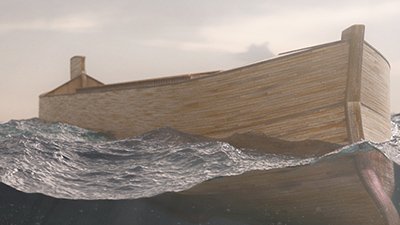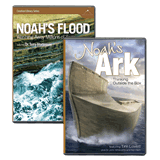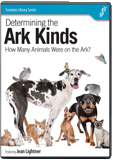
What Happened to the Animals After Noah’s Ark?
Stepping Back in Time
In our previous articles, we observed that Noah took just a few thousand animals on board the Ark. They survived the yearlong Flood and then stepped off the ship around 4,500 years ago.
And then? Where did they go? What was their fate?
As we discovered in previous posts, the kinds that Noah brought aboard the Ark are approximated by a classification rank somewhere around family and order. In other words, Noah would have brought two representatives from the cat family, not two tigers, two lions, and two ocelots.
The Fact of Mammalian Extinction
In calculating the total number of these kinds that went on board the Ark, we included fossil families as well as living families. Among mammal families, we found that the families alive today represent only approximately 30% of the mammal families that ever existed.1 Which means that around 70% of mammal families are now extinct.
In other words, 70% of the kinds of mammals that Noah brought on board the Ark died. This is not extinction by virtue of burial in the Flood. Rather, it’s extinction after the Flood.
This fact may seem counterintuitive. If the purpose of the Ark was survival, why let over two-thirds of the kinds die off after the voyage was complete? To a skeptic, this fact might intimate failure on the part of God.
The Theology of Mammalian Extinction
However, following this logic through to its conclusion, the skeptic would then also need to conclude that not only the Ark but also the Flood was a failure as well. After all, salvation via the Ark wasn’t the only purpose God achieved in the Flood narrative; He was equally determined to judge sinful humanity who refused to repent and exercise faith.
Yet in just a few generations following the Deluge, the descendants of faithful, righteous Noah descended into gross wickedness again. Mankind rebelled in trying to build a tower to the heavens (Genesis 11:1–9). In response, God judged mankind again, not by sending a global Flood (since He promised to never do so again) but by confusing the languages of mankind.
The speed with which mankind turned his back on his Creator revealed in bold colors the fundamental depravity of the human heart—and hence his need for a Savior.
Since mankind fell so quickly into sin again, did God fail to judge sin adequately in the Flood? Was His initial judgment inadequate or poorly designed? No. The Tower of Babel incident was not a compensation for—or correction of—prior failures. Rather, in the Flood, all of rebellious mankind died. In other words, the Flood was a very successful event.
What purpose then did the post-Flood return to depravity serve? If nothing else, the speed with which mankind turned his back on his Creator revealed in bold colors the fundamental depravity of the human heart—and hence his need for a Savior.
Furthermore, it appears that God intended to give humanity an unforgettable reminder of this fact in the long history that followed Babel. God didn’t send the Savior immediately following the Tower of Babel incident. Instead, He waited approximately 2,000 years before sending His Son. In other words, God has given mankind two ways in which to discover his sinfulness. First, by telling man explicitly in the Scriptures of his fallen state (e.g., Romans 3:23), mankind learns of his precarious eternal condition and pending doom. Second, by letting humanity flounder for thousands of years, God showed mankind just how wicked his heart really was.
Hence, the timing of post-Flood events in the human realm fulfilled a gospel purpose—revealing man’s profound inability to save himself and his desperate need of a Savior, which foreshadowed Christ’s condescension and salvific atonement—hardly a failure on God’s part. In fact, the skeptic should be thankful for this reminder of mercy in the Cross rather than be upset that somehow God had failed to achieve His purposes.
Could a similar explanation (e.g., man’s depravity) also be true in the realm of animal extinctions? At the completion of the Flood, God decreed, “Every moving thing that lives shall be food for you” (Genesis 9:3). In light of Genesis 1:30, this divine directive appears to have been a significant change in practice for humans. Specifically, it appears that humans were strictly vegetarian before the Flood (Genesis 1:30) and then switched to a carnivorous diet after the Deluge.
Human carnivory would necessitate the death of animals.
Obviously, human carnivory would necessitate the death of animals. Today, humans obviously take advantage of the Genesis 9 permission to eat meat, but some do so to sinful excess. For example, one of the major causes of extinction today is human activity. Thus excessive—if not sinfully motivated—post-Flood hunting may have played a part in the extinction of 70% of mammal kinds.2 If so, this fact would not expose failure on the part of God; instead, it would highlight man’s depravity and need of a Savior.
Theological objections aside, from a scientific perspective the extinction of mammal kinds was not comprehensive in its scope. While 70% died, roughly 30% of mammal kinds survived. Thus, once the skeptic discovers the shallowness of his theological objections to mammalian extinction, he is faced with another challenge to his view: The passengers on board the Ark were not cute inventions designed to round out a dramatic—but mythical—story. Instead, they were real creatures who boarded the Ark, survived the Flood, disembarked the Ark, avoided extinction, and left an echo of their existence that reverberates to this day.
Footnotes
- Nathaniel T. Jeanson and Jason Lisle, “On the Origin of Eukaryotic Species’ Genotypic and Phenotypic Diversity: Genetic Clocks, Population Growth Curves, and Comparative Nuclear Genome Analyses Suggest Created Heterozygosity in Combination with Natural Processes as a Major Mechanism,” Answers Research Journal 9 (2016): 81–122, https://answersingenesis.org/natural-selection/speciation/on-the-origin-of-eukaryotic-species-genotypic-and-phenotypic-diversity/.
- Other processes surely played a part as well. For example, creationists postulate an Ice Age in the few centuries following the Flood; this dramatic change in climate may have also influenced the survival and extinction of various kinds.
Recommended Resources

Answers in Genesis is an apologetics ministry, dedicated to helping Christians defend their faith and proclaim the good news of Jesus Christ.
- Customer Service 800.778.3390
- © 2024 Answers in Genesis




